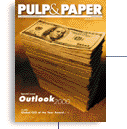|

HAROLD M. CODY
is Editorial Director of Pulp & Paper magazine

NEW LINER PM
Solvay’s new containerboard machine, up and running at the Syracuse, NY mill, is one of the few new machines to start up in North America.
E-COMMERCE
A special report on e-Commerce in the pulp and paper industry examines where this technology is headed. Among areas examined are pulp and paper transactions, and equipment and chemicals purchasing, customer support and logistics.
BELT DRYING
Second commercial application of belt drying, running on an Asian containerboard machine, is discussed in this mill-based application story.
|

Big changes for 2000
This, the first issue for the year 2000, includes several articles that set the stage for the upcoming year in the pulp and paper industry in North America. We are also introducing a new feature to the magazine in the form of a new column that will be an addition to the current maintenance and career columns.
We lead off with our annual in-depth outlook and review article—Outlook 2000. Our staff of editor’s reviews key events of 1999 and outlines the likely direction of the industry in 2000 and beyond. As one analyst recently put it, “The stars and moon are all aligned,” meaning that all signs point towards the next year or two or even three, as being the best period for the industry since 1994 to 95. None of this will come to pass, of course, if all of the players in the industry lose sight of what got us to this point in the first place, i.e., some old bad habits changed, and they return to the ways of the past. However, for the time being, the outlook is as good as it’s been in years. Of course, it’s not bright and rosy if you work in a mill and have lost a job, but for the overall industry things look to be headed up.
Almost all key prognosticators, including the major industry forecasting groups (including our own Pulp & Paper Forecaster) and financial analysts that follow the industry look for 2000 to be a good year. In some key grades—such as pulp and linerboard—major price recoveries have occurred. For other grades, while the outlook may be more subdued, the future looks reasonably positive. The biggest questions remain: can the U.S. economy continue to grow unabated over the next 2 to 3 years, and can other areas of the world recover as well.
Outlook includes our annual review of pulp and paper capital spending, which, if you sell equipment or design paper mills, isn’t all that positive. Spending levels remain very constrained as the industry’s senior management focuses on the bottom line. Hopefully, some of the gains in earnings expected will be funneled into capital improvements to keep our mill base competitive as the year progresses. They have to.
Capital Spending Restrained. While spending remains comparable with last year, at historically low levels, the mix has changed reflecting the fiscal restraint of the major producer’s as well as new priorities. For example, spending on new machines is down considerably, but this drop is offset by increased investments aimed at meeting environmental standards. A feature story in this issue provides a detailed review of a key area—air compliance—a major aspect of the Cluster Rules. The mill’s water effluent side has received most of the attention so far but looming regulations on hazardous air pollutants will cost mills money and require investment.
P&P CEO Award. Also in this issue is a story about one of the most influential CEO’s in the paper business, and one of the reasons, according to many, that we’re in somewhat good shape in the first place. Announced in late 1999 as the inaugural recipient of the Pulp & Paper/PPI Global CEO of the Year in the paper/forest products industry is Dr. Michael W.J. Smurfit, CEO of Jefferson Smurfit Group plc. It was his company’s bold acquisition of Stone Container, followed by the unprecedented step of the closing of 1.1 million tons of capacity, that are in the view of many in the industry, practically a watershed event in the North American, and for that matter, worldwide paper industry. Over 200 money managers and financial analysts voted, making it the only magazine award that is independently voted on for anything relating to performance. While Pulp & Paper sponsors it, I think it goes without saying that this is the most unbiased award of its nature in the industry.
Along the same lines, in terms of looking to the future as do the previous articles outlined, we’ve introduced a new column to Pulp & Paper beginning with this issue. Our column on Information Technology will run every other month, alternating with a column on Papermaking Chemicals. IT is a key investment all companies are making to improve operations, lower costs, and serve their customers. Jim McGrane, V.P. at Mead Corp, authors our first column. He offers some valuable insights into what it takes to really make IT effective, noting that the human side, i.e., acceptance and use of this technology—is key to its, and our industry’s success.
Upcoming columns on chemicals will cover key trends in this important mill operating cost area, an increasingly important component of a mill furnish. More and more production is moving to value added paper and board grades that have functional chemicals or pigments added to enhance performance.

|




